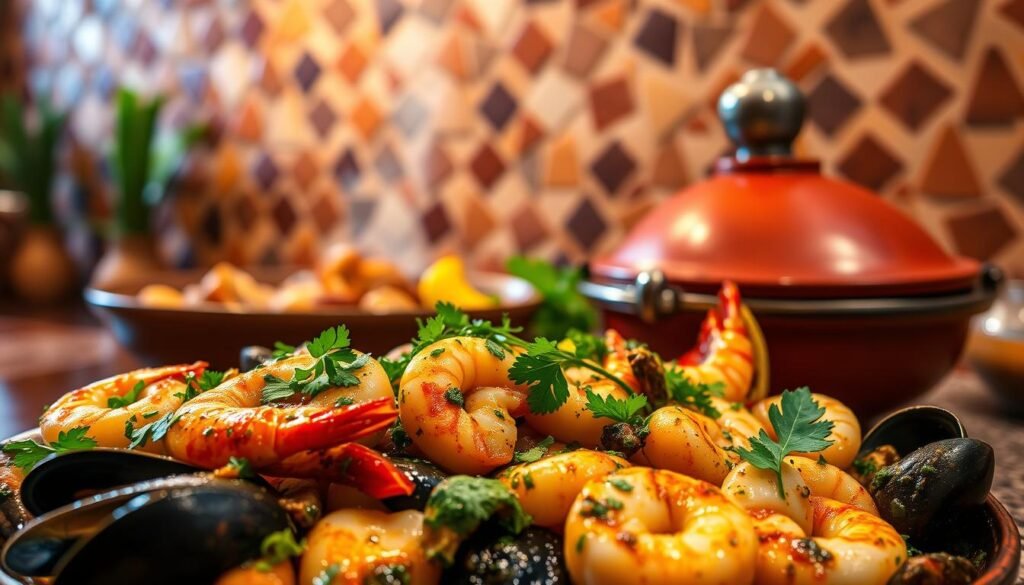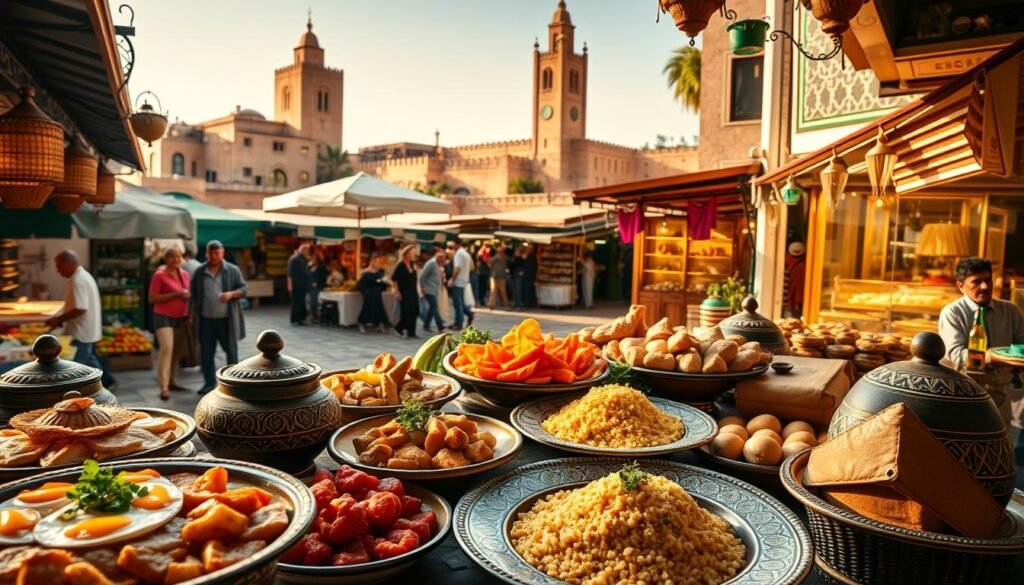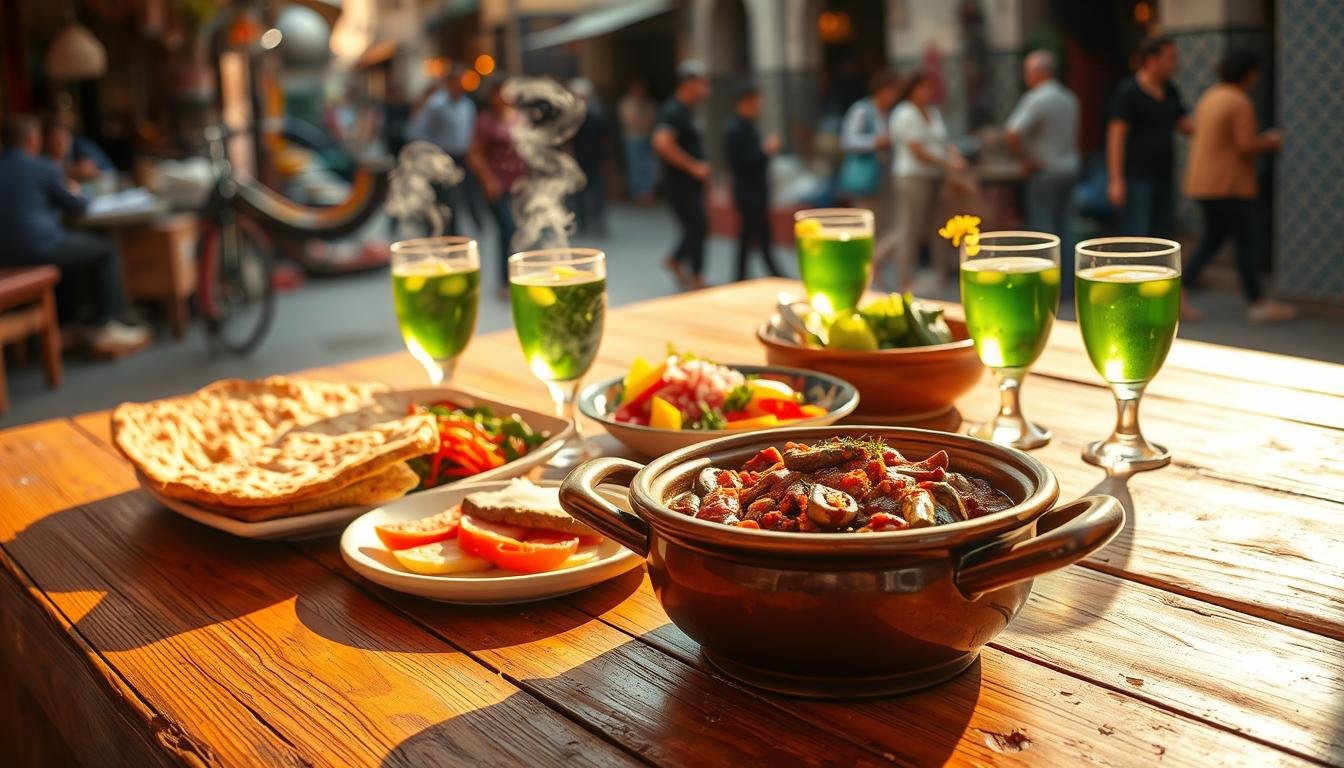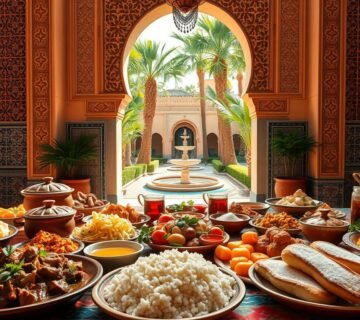Embark on a culinary journey through Morocco and experience the rich flavors and aromas of North African cuisine.
Moroccan cuisine is a vibrant blend of different cultures, including Berber, Arab, Mediterranean, French, and Spanish influences. This diverse heritage has shaped the country’s iconic dishes and regional variations.
As we explore the world of Moroccan food, we’ll delve into its rich heritage, savor iconic dishes, and uncover the secrets behind its unique flavors.
Key Takeaways
- Explore the rich cultural heritage of Moroccan cuisine
- Discover iconic dishes and regional variations
- Learn about the unique flavors and ingredients used in North African cooking
- Uncover the secrets behind Moroccan cuisine’s diverse influences
- Experience the vibrant atmosphere of Moroccan street food
The Rich Heritage of Moroccan Cuisine
The rich heritage of Moroccan cuisine is a reflection of its diverse history and geography. Moroccan food has been shaped by various cultural influences, creating a unique flavor profile that is both exotic and familiar.
Cultural Influences on Moroccan Food
Moroccan cuisine is a blend of different cultures, including Berber, Arab, and Mediterranean traditions. The Berber people, indigenous to North Africa, have contributed significantly to the country’s culinary identity. Arab influences introduced new ingredients and cooking techniques, while Mediterranean trade brought exotic spices and flavors.
Berber, Arab, and Mediterranean Roots
The combination of these influences has resulted in a distinct culinary style. For example, the use of ras el hanout, a blend of spices, is a hallmark of Moroccan cooking. This spice mix can include over 30 different spices, reflecting the country’s historical trade connections.
French and Spanish Colonial Impact
The legacy of French and Spanish colonialism is also evident in Moroccan cuisine. French patisserie and Spanish seafood dishes have been incorporated into the local food culture, adding another layer of complexity to the nation’s culinary heritage.
The Philosophy Behind Moroccan Cooking
At the heart of Moroccan cooking is the balance of flavors and textures, as well as communal dining traditions. Meals are often seen as opportunities to bring people together, fostering a sense of community and hospitality.
Balance of Flavors and Textures
Moroccan dishes typically balance sweet, sour, salty, and spicy flavors. The texture of food is also important, with a mix of tender meats, crunchy vegetables, and soft grains.
Communal Dining Traditions
In Morocco, dining is a communal activity. Food is often served on large platters, encouraging sharing and togetherness among diners. This tradition reflects the country’s values of hospitality and generosity.
Essential Ingredients in Moroccan Food in Morocco
The essence of Moroccan cooking lies in its ingredients, a blend of spices, fresh produce, and staple items. Moroccan cuisine is known for its rich flavors, which are achieved through the use of a variety of ingredients.
Spices That Define Moroccan Flavors
Spices play a crucial role in defining the flavors of Moroccan dishes. Ras el Hanout, which translates to “head of the shop,” is a complex blend of spices that can include over 30 different components, such as cumin, coriander, cinnamon, and turmeric.
Ras el Hanout and Its Components
Ras el Hanout is a signature spice mix in Moroccan cuisine, with its composition varying from region to region and even from shop to shop. The blend can include ingredients like rose petals, cardamom, and black pepper, giving it a unique aroma and flavor.
Saffron, Cumin, and Cinnamon
Other key spices in Moroccan cooking include saffron, known for its luxurious flavor and color, cumin, which adds warmth, and cinnamon, used for its sweet and spicy flavor. These spices are often used together to create the characteristic flavors of Moroccan dishes.
Fresh Produce and Staple Ingredients
Fresh produce and staple ingredients are also vital in Moroccan cuisine. Ingredients like olives, preserved lemons, and argan oil are commonly used.
Olives, Preserved Lemons, and Argan Oil
Olives are used in various dishes, while preserved lemons add a salty, tangy flavor. Argan oil, with its nutty flavor, is used both in cooking and as a finishing oil.
Preserved and Fermented Components
Preserved and fermented ingredients add depth to Moroccan dishes. These include preserved lemons and olives, as well as other fermented foods that contribute to the cuisine’s complexity.
Understanding these essential ingredients is key to appreciating Moroccan cuisine. Each component, whether a spice, fresh produce, or staple ingredient, plays a vital role in the flavors and traditions of Moroccan cooking.
Iconic Moroccan Dishes You Must Try
When exploring Moroccan food, there are several iconic dishes that you simply can’t miss. Moroccan cuisine is known for its rich flavors and diverse cooking techniques, resulting in a culinary experience that’s both exciting and authentic.
Tagine Varieties and Their Origins
Tagine is one of Morocco’s most famous dishes, named after the earthenware pot in which it’s cooked. This slow-cooked stew can be made with various ingredients, including chicken, lamb, or vegetables.
Chicken with Preserved Lemon and Olives
A classic tagine variety, chicken with preserved lemon and olives, offers a tangy and savory flavor profile. The preserved lemons add a salty, slightly sweet taste, while the olives provide a rich, briny flavor.
Lamb with Prunes and Almonds
Another popular tagine variation is lamb with prunes and almonds. The sweetness of the prunes pairs perfectly with the tender lamb, while the almonds add a satisfying crunch.
Couscous: The National Dish
Couscous is Morocco’s national dish, typically served on Fridays and special occasions. It’s made from semolina flour and is often accompanied by a variety of vegetables and meats.
Seven Vegetable Couscous
Seven vegetable couscous is a traditional and flavorful variation, featuring a mix of vegetables such as carrots, zucchini, and bell peppers, all cooked to perfection.
Pastilla and Other Special Occasion Foods
Pastilla is a sweet and savory pie that’s a staple at Moroccan celebrations. It’s typically made with layers of flaky pastry, meat, onions, and spices.
Mechoui (Slow-Roasted Lamb)
Mechoui, or slow-roasted lamb, is another dish often served at special occasions. The lamb is marinated in a blend of spices and then roasted to tender perfection.
These iconic Moroccan dishes showcase the country’s rich culinary heritage and are a must-try for anyone looking to experience the authentic flavors of Morocco.
Regional Variations of Moroccan Cuisine
From the coast to the mountains and desert, Moroccan cuisine varies greatly from region to region. This diversity is a reflection of Morocco’s geography, cultural influences, and historical trade routes.
Coastal Delicacies of Essaouira and Agadir
The coastal towns of Essaouira and Agadir are renowned for their fresh seafood. One of the standout dishes from this region is seafood chermoula, a flavorful preparation of fish marinated in a mixture of herbs, lemon, and olive oil.
Seafood Chermoula
Seafood chermoula is a testament to the simplicity and elegance of Moroccan coastal cuisine. The dish is typically made with a variety of fish, mixed with chermoula sauce—a blend of parsley, cilantro, garlic, and lemon juice—and then grilled to perfection.

Mountain Cuisine of the Atlas Region
The Atlas Mountains are home to the Berber communities, whose cuisine is characterized by hearty, slow-cooked dishes. Berber tagines are a staple, made with meat, vegetables, and dried fruits, all cooked in a traditional clay pot.
Berber Tagines and Stews
Berber tagines and stews are comforting and rich, often featuring lamb or chicken cooked with a variety of spices and sometimes preserved lemons. These dishes are slow-cooked over open fires, infusing the ingredients with deep flavors.
Desert Specialties from the Sahara
The Sahara Desert region is known for its unique culinary traditions, often centered around dates and lamb. Date and lamb dishes are particularly popular, with the sweetness of dates complementing the richness of lamb.
Date and Lamb Dishes
In the Sahara, dates are not just a sweetener but a key ingredient in savory dishes. When combined with lamb, they create a flavor profile that is both rich and balanced. These dishes are often slow-cooked, allowing the flavors to meld together.
| Region | Specialty | Key Ingredients |
|---|---|---|
| Coastal (Essaouira, Agadir) | Seafood Chermoula | Fish, herbs, lemon, olive oil |
| Mountain (Atlas) | Berber Tagines | Meat, vegetables, dried fruits |
| Desert (Sahara) | Date and Lamb | Dates, lamb, spices |
Street Food Adventures in Morocco
Morocco’s street food scene is a culinary adventure waiting to be explored. The country’s vibrant markets and souks offer a wide range of delicious and authentic street food that reflects the rich cultural heritage of Morocco.
Navigating Food Souks and Markets
One of the most iconic food souks in Morocco is Jemaa el-Fnaa in Marraquexe. This bustling square is a sensory experience, with food stalls offering a variety of traditional Moroccan dishes. Visitors can sample local specialties, watch street performers, and soak up the lively atmosphere.
Jemaa el-Fnaa in Marrakech
Jemaa el-Fnaa is a must-visit destination for any food enthusiast. The square is surrounded by stalls selling everything from fresh produce to traditional handicrafts. At night, the area transforms into a vibrant food market, with stalls offering a range of grilled meats, stews, and other local delicacies.
Must-Try Moroccan Street Snacks
Some of the must-try street snacks in Morocco include msemen, harcha, and sfenj. Msemen is a thin, folded pancake filled with spices and herbs, while harcha is a dense, cornbread-like snack. Sfenj is a type of doughnut that is fried and often enjoyed with a cup of coffee or tea.
Msemen, Harcha, and Sfenj
These snacks are not only delicious but also offer a glimpse into Morocco’s culinary traditions. Visitors can sample these snacks at food stalls and markets throughout the country.
Grilled Meats and Sandwiches
In addition to traditional snacks, Moroccan street food also includes a variety of grilled meats and sandwiches. Visitors can enjoy skewers of marinated meat, often served with a side of spices and bread.
Food Safety Tips for American Travelers
While exploring Moroccan street food can be a fun and delicious experience, it’s essential for American travelers to take food safety precautions. Stick to busy food stalls and markets, avoid undercooked meat, and drink bottled or filtered water to minimize the risk of foodborne illness.
The Art of Moroccan Bread and Pastries
In Morocco, bread and pastries are not just food items, but symbols of hospitality and community. The art of creating these staples is a tradition passed down through generations, with each region adding its unique twist.
Traditional Bread Varieties
Moroccan cuisine boasts a diverse array of traditional bread, with khobz and batbout being among the most popular. Khobz, a round, crusty bread, is a staple in Moroccan households, often served with meals or used to scoop up various dishes.
Khobz and Batbout
Khobz is typically made from a simple dough of flour, water, yeast, and salt, then baked in a wood-fired oven. Batbout, on the other hand, is a softer, slightly sweet bread, often used for sandwiches or served with olive oil and spices.
Sweet Treats and Honey-Soaked Pastries
Moroccan pastries are renowned for their intricate designs and sweet flavors. Chebakia, ghriba, and briouat are just a few examples of the delicious treats enjoyed during special occasions.
Chebakia, Ghriba, and Briouat
Chebakia are flower-shaped cookies deep-fried and coated in honey, often sprinkled with sesame seeds. Ghriba are shortbread-like cookies made with ground almonds and flavored with rose water or orange blossom water. Briouat are flaky pastry triangles filled with almond paste or meat, typically served as an appetizer or dessert.
The Social Importance of Bread in Moroccan Culture
Bread plays a significant role in Moroccan culture, symbolizing hospitality, generosity, and community. In Moroccan households, breaking bread together is a daily ritual that fosters a sense of togetherness and respect.
The act of sharing bread is also a sign of respect and hospitality towards guests. When visiting a Moroccan home, it’s customary to be offered bread and other traditional foods as a gesture of welcome.
Moroccan Tea Culture and Beverages
The art of Moroccan tea-making is a revered tradition that embodies the country’s rich cultural heritage and hospitality. In Morocco, tea is not just a drink; it’s an integral part of daily life and social interactions.
The Ritual of Mint Tea
Mint tea, known as “Atay,” is a staple in Moroccan culture, symbolizing hospitality and respect. The preparation of mint tea is a meticulous process that involves:
- Selecting high-quality green tea leaves
- Adding fresh mint leaves for flavor and aroma
- Using the three-pour method to ensure a perfect blend
The Three-Pour Method
The three-pour method is a traditional technique where tea is poured from a height into a glass, then back into the teapot, and finally into the glass again. This process aerates the tea, enhancing its flavor and aroma.
Other Traditional Drinks
Beyond mint tea, Morocco offers a variety of traditional beverages. These include:
Almond Milk and Orange Blossom Water
Almond milk and orange blossom water are popular ingredients in Moroccan desserts and drinks. Almond milk is made by blending almonds with water, while orange blossom water is distilled from orange blossoms, adding a fragrant flavor to various beverages.
Fresh Fruit Juices and Smoothies
Fresh fruit juices and smoothies are refreshing options, often made with local fruits like oranges, strawberries, and bananas. These drinks are not only delicious but also provide a cool respite from the heat.
Where to Find the Best Moroccan Food in Major Cities
Morocco’s culinary scene is a vibrant reflection of its rich cultural heritage, with major cities offering a diverse range of dining experiences. From traditional eateries to modern fusion restaurants, each city has its unique flavor profile.
Marrakech’s Culinary Highlights
Marraquexe is renowned for its vibrant food scene, with the medina offering a plethora of traditional restaurants serving authentic Moroccan dishes.
Restaurants in the Medina
The medina is home to numerous restaurants, each offering a unique dining experience. Visitors can enjoy traditional tagines and couscous in a historic setting.
Modern Dining in Gueliz
Gueliz, the modern district of Marraquexe, boasts a range of contemporary restaurants offering fusion cuisine and innovative dining experiences.
Fez’s Traditional Eateries
Fez is known for its historic restaurants in Fez el-Bali, where visitors can sample traditional Moroccan cuisine in an authentic setting.
Historic Restaurants in Fez el-Bali
Fez el-Bali’s narrow streets are lined with traditional restaurants, offering a range of local specialties and historic ambiance.
Casablanca’s Modern Food Scene
Casablanca is a hub for modern Moroccan cuisine, with a range of fusion restaurants and upscale dining establishments.
Fusion Restaurants and Upscale Dining
Casablanca’s restaurants offer a blend of traditional Moroccan flavors with international cuisine, providing a unique dining experience.
Hidden Gems in Smaller Towns
Smaller towns like Chefchaouen and Tânger offer their own unique culinary delights, worth exploring for any food enthusiast.
Chefchaouen and Tangier Specialties
Chefchaouen is known for its local produce and traditional dishes, while Tânger offers a mix of Moroccan and Mediterranean cuisine.

| City | Notable Dish | Dining Experience |
|---|---|---|
| Marraquexe | Tagine | Tradicional medina restaurants |
| Fez | Couscous | Historic eateries in Fez el-Bali |
| Casablanca | Seafood | Modern fusion restaurants |
| Chefchaouen | Local produce dishes | Quaint, laid-back eateries |
| Tânger | Mediterranean fusion | Upscale dining with sea views |
“The flavors of Morocco are a journey through its diverse landscapes and cultural heritage, with each city offering a unique culinary experience.”
Dining Customs and Etiquette in Morocco
The art of dining in Morocco is steeped in etiquette and tradition, reflecting the country’s rich cultural heritage. Understanding these customs is essential to fully appreciate the Moroccan dining experience.
Traditional Seating and Eating Practices
In Morocco, traditional dining involves sitting on cushions or low chairs around a low table. Eating with your right hand is a significant practice, as the left hand is considered unclean.
Eating with Your Right Hand
Using your right hand when eating is not just a matter of hygiene; it’s a sign of respect for the culture and the people you’re dining with.
Hospitality Rituals and Expectations
Moroccans take great pride in their hospitality. When invited to a Moroccan home, accepting food and drink offerings is a sign of respect.
Accepting Food and Drink Offerings
When offered food or drink, it’s polite to accept. Refusing can be seen as impolite, though it’s acceptable to decline a second helping if you’re full.
Navigating Ramadan and Other Religious Considerations
During Ramadan, it’s crucial to be respectful of those fasting. Avoid eating or drinking in public during fasting hours.
Respectful Behavior During Holy Months
Being mindful of local customs during religious periods is key to a respectful and enjoyable experience.
| Dining Custom | Description | Significance |
|---|---|---|
| Eating with Right Hand | Using the right hand for eating | Sign of respect and hygiene |
| Accepting Offerings | Accepting food and drink | Shows appreciation for hospitality |
| Ramadan Respect | Avoiding public eating during fasting hours | Respect for those fasting |
Bringing Moroccan Flavors Home
With the right spices and ingredients, you can infuse your cooking with the authentic taste of Morocco. Recreating Moroccan dishes at home can be a fun and rewarding experience, allowing you to explore the rich culinary heritage of this North African country.
Spices and Ingredients to Purchase
To start cooking Moroccan cuisine, you’ll need to stock up on essential spices and ingredients. Visiting Moroccan markets can be a great way to discover new flavors, but it’s crucial to understand what can be legally imported into the US.
Navigating Spice Markets
Moroccan spice markets, or souks, are a treasure trove of aromatic spices, herbs, and other ingredients. When shopping, look for ras el hanout, a blend of spices that is a cornerstone of Moroccan cooking.
What’s Legal to Import to the US
Before bringing back spices or ingredients from Morocco, check the US Customs and Border Protection website for the latest regulations. Certain products, especially those derived from animals or plants, may be restricted or require special permits.
Simple Moroccan Recipes for American Kitchens
Moroccan cuisine offers a variety of dishes that can be easily adapted for home cooking. Two staples are tagines and salads.
Basic Tagine Technique
A tagine is a slow-cooked stew named after the clay pot in which it’s cooked. To make a basic tagine, you’ll need protein (chicken, beef, or lamb), vegetables, and a blend of spices. Slow cooking is key to developing the rich flavors.
Moroccan Salads and Sides
Moroccan salads, such as salade marocaine, are refreshing and flavorful. They typically include ingredients like tomatoes, peppers, onions, and olives, dressed with olive oil and lemon juice.
| Ingredient | Use in Moroccan Cuisine |
|---|---|
| Ras el hanout | Spice blend used in tagines and couscous |
| Preserved lemons | Adds salty, tangy flavor to tagines and salads |
| Cumin | Used in spice blends and as a seasoning |
Moroccan Cooking Classes for Tourists
For a hands-on experience, consider taking a Moroccan cooking class. Many top-rated cooking schools offer classes for tourists.
Top-Rated Cooking Schools
Schools like Cooking with the Locals in Marrakech offer immersive culinary experiences, teaching you how to prepare traditional Moroccan dishes.
Conclusion: Embracing the Flavors of Morocco
Moroccan cuisine offers a rich culinary journey, with its diverse flavors and cultural influences. From iconic dishes like tagine and couscous to regional variations and street food adventures, the country’s gastronomic traditions are a true reflection of its heritage.
As you explore the flavors of Morocco, you’ll discover the importance of spices, fresh produce, and traditional cooking methods. Whether you’re cooking Moroccan recipes at home or dining at a local restaurant, the experience is sure to be memorable.
The culinary journey through Morocco is not just about the food; it’s about the culture, hospitality, and traditions that bring people together. By embracing the flavors of Morocco, you’ll gain a deeper appreciation for this beautiful country and its people.



No comment